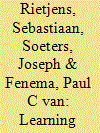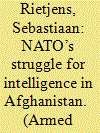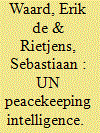| Srl | Item |
| 1 |
ID:
172924


|
|
|
|
|
| Summary/Abstract |
Intelligence in defence organizations is widely seen as an under-researched topic. This paper assesses this claim and, by means of a metareview, systematically analyses the body of literature that has focused on intelligence in defence organizations between 2009 and 2018. The review includes 13 key journals on intelligence studies (e.g., Intelligence and National Security), military studies (e.g., Small Wars and Insurgencies) and conflict and peace studies (e.g., Journal of Strategic Studies). The analysis provides insight on the focus areas, the timeframes and conflicts that are addressed as well as the authors involved. Based on this, the paper provides suggestions for further research into intelligence within defence organizations.
|
|
|
|
|
|
|
|
|
|
|
|
|
|
|
|
| 2 |
ID:
120308


|
|
|
|
|
| Publication |
2013.
|
| Summary/Abstract |
Uruzgan Province is widely seen as one of the few areas where positive developments occurred in Afghanistan's south. A major reason for this success is believed to be the comprehensive approach that was adopted to address the complex and multifaceted nature of problems. This article analyses the coordination between the Dutch military and the wide variety of civil actors that took place during the period 2006-2010 in Uruzgan as this was a key element within the comprehensive approach. Making use of inter-organizational network theory, the article identifies and analyses three dimensions of civil-military coordination: interdependence, (in)coherence of logics and conditions for coordination. Based on these dimensions the article develops a strategic compass that guides military forces in establishing and managing their relationships with civil actors.
|
|
|
|
|
|
|
|
|
|
|
|
|
|
|
|
| 3 |
ID:
193063


|
|
|
|
|
| Summary/Abstract |
What role did North Atlantic Treaty Organization (NATO) and the coalition (International Security Assistance Force—ISAF) it led play in the failure of the West in Afghanistan? This essay argues that the ISAF intelligence community’s inability to come to grips with the complex operational environment in Afghanistan contributed to the problem. Using three concepts from the complexity literature, requisite variety, learning, and enactment, I analyze critical flaws in NATO’s approach. ISAF’s weak cross-cultural competence, its inconsistent relationships with international civilian organizations, and its absence of double- and triple-loop learning are identified as key drivers of NATO’s weak intelligence performance.
|
|
|
|
|
|
|
|
|
|
|
|
|
|
|
|
| 4 |
ID:
153170


|
|
|
|
|
| Summary/Abstract |
Today’s military missions are often broad in scope and face a multitude of political, socio-economic, and security challenges. Enemy-centric intelligence is therefore no longer sufficient. Based on their experiences in Afghanistan, retired General Michael T. Flynn and his colleagues noted that U.S. and allied forces were unable to answer the fundamental questions about their operational environment and the people they sought to persuade:
|
|
|
|
|
|
|
|
|
|
|
|
|
|
|
|
| 5 |
ID:
166781


|
|
|
|
|
| Summary/Abstract |
Coherence is a core objective in most multinational interventions and seems of particular relevance to UN peacekeeping missions with their increasing complexity and multidimensionality. Yet, coherence has rarely been studied empirically. We borrow the concept of ‘fit’ from organizational theory and use it to develop a conceptual framework to study coherence in peacekeeping operations. Fit is the degree of match between what is required by the mandate, on the one hand, and an institutional set-up and the implemented practices, on the other. We identify three relevant dimensions of fit to study coherence: strategic and organizational, cultural and human and operational fit. Our empirical material focuses on the UN mission in Mali (MINUSMA) and in particular on the interplay between the intelligence components and the rest of the mission. We draw upon a large empirical dataset containing over 120 semi-structured interviews, field observations and participation in pre-deployment exercises and evaluation sessions. Our empirical analysis suggests that low level of fit across several dimensions leads to inertial and widespread frictions in the practice of peacekeeping and could potentially undermine peacekeeping effectiveness. Building on existing scholarship on micro-level approaches to peacekeeping, we hope to further the debate on organizational dynamics within peace operations.
|
|
|
|
|
|
|
|
|
|
|
|
|
|
|
|